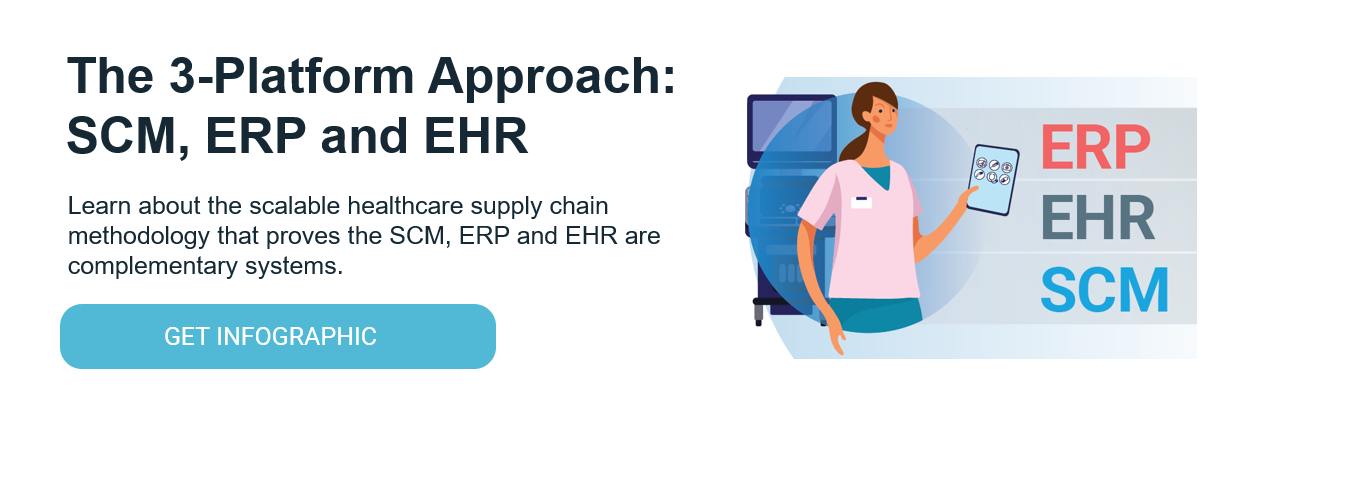ERP vs. SCM: Beyond the Basics

In a previous blog post, I described the difference between enterprise resource planning (ERP) and supply chain management (SCM) systems when managing supply inventory. We determined that a health system can round out its digital strategy by fully integrating both supply chain systems alongside the electronic health record (EHR). The ERP vs. SCM approach will only continue to deliver inefficient inventory management solutions.
Now let’s look at the historic roles of group purchasing organizations (GPO), distributors and manufacturers in driving supply chain strategies centered around the ERP and how today’s generation of supply chain leaders are taking control by leveraging SCM systems for a holistic approach to healthcare supply chain management, including mergers and acquisitions (M&A) consolidation, self-distribution, demand planning and forecasting.
The Historic Approach: In the Hands of Third Parties
Historically, a health system or hospital’s supply chain was managed by its GPO, distributors and manufacturers.
The GPO established the health system’s medical/surgical supply prices, the distributor either delivered case-level or lowest unit of measure (LUM) inventory to the hospitals and clinics, and the manufacturers of special order or consignment products used in the perioperative space and cath/IR labs managed this inventory.
The role of ERPs from a supply chain perspective is to store the pricing contracts and provide procurement workflows for medical/surgical supplies within the item master. ERPs also have basic functionality to receive items into inventory, manage stock locations and facilitate reordering.
Supplies used in the perioperative space and cath/IR labs typically fall outside of the ERP/item master. Pharmaceuticals too have historically been managed outside of the ERP by pharmacy staff members with their own standalone systems.
The Modern Model: Supply Chain in Control
With supply chain expenses constantly on the rise and growing recognition among healthcare leaders of the impact that supplies have on patient outcomes and overall costs, health systems and hospitals are increasingly taking control of their supply chains. The result is improved service levels to their facilities and greater levels of patient safety and care.
Holistic Supply Management
Supply chain leaders, seeking greater visibility into their operations, have been implementing SCM platforms capable of managing ALL inventory, including those used in the perioperative space, cath/IR labs and pharmacy.
Through the SCM system, they can track an item from the time it was received into the organization through when it was used on a patient, wasted or discarded, and every step in between (e.g., storage locations, product transfer between departments or facilities, etc.).
Through full integration with the EHR, the SCM automates product data capture at the point of use (POU) for complete product tracking and accurate charge capture and billing. It even alerts clinicians when they attempt to use an expired product on a patient.
The SCM offers access to product reports and analytical data that can improve performance levels and help drive informed decision-making among all stakeholders.
SCM for Streamlined M&A
Health systems continue to merge or acquire hospitals as a strategy to reduce costs and increase revenues. But a survey of 2,300 hospitals that had undergone M&A found they are spending an average of 18% more on supply chain operations, processes and products post-transaction.
One of the challenges of M&A from a supply chain perspective that can increase costs is the need to consolidate to a single ERP system. That effort can take many years and be a significant financial investment.
An SCM system provides a much faster, more efficient way of getting control of the new system’s supply chain and gaining the efficiencies of the M&A. Rather than divide the systems into ERP vs. SCM, the SCM platform can operate agnostically to the ERP and connect to the new facility’s existing system for orders using traditional electronic data interchange (EDI) transactions.
Additionally, it can maintain a central item master, use distributed order management (DOM) to source inventory, implement standard operating procedures (SOP) for POU in perioperative and cath/IR labs, manage general supplies at nursing stations and provide an overall system forecast or plan for buying all inventory types.
ERP vs. SCM: Self-distribution
Taking it a step further for true consolidation and control, health systems are establishing their own consolidated service centers (CSC) for self-distribution and perpetual inventory management.
Health systems with CSCs are stocking their top medical/surgical and personal protective equipment (PPE) items in bulk, along with perioperative and pharmacy products, and supplying their care sites through self-distribution.
In conjunction with the SCM, health systems with CSCs are using: robust warehouse management systems (WMS) to receive supply in bulk and break down into LUM deliveries; demand planning (DP) systems to recommend optimal buys based on consumption and ordering patterns; and delivery management (DM) systems to control deliveries to hospitals, clinics and physician’s offices, and also manage trucks and drivers. ERP systems have none of these features.
From a Transactional to a Strategic Supply Chain
In the historic model, where a healthcare organization’s supply chain was managed by its GPO, distributors and manufacturers, the organization had to rely on these third parties for data and analytics to measure its supply chain performance. Essentially, supply chain leaders didn’t own their own data — it was in the hands of someone else.
In today’s environment of value-based care, supply data is essential for evaluating quality and cost. With the move to a more clinically integrated supply chain (CISC), supply chain leaders need real-time, accurate and credible data to share with clinical teams to demonstrate the impact of supply choices on clinical and financial outcomes.
Healthcare organizations that have consolidated supply chain processes within an SCM platform and made the move to self-distribution have become the owners of this critical information. It is readily available at their fingertips as opposed to being under a third party’s control.
With complete visibility into inventory status and immediate access to data and analytics, supply chain leaders are rapidly shifting from transactional to strategic supply chain management. Between the ERP and SCM, the ERP has no real access to data tools or reporting.
Demand Planning and Forecasting
This new model of data ownership is key to demand planning, which is a supply chain management process that enables a prediction of demand based on numbers seen in the past.
A demand plan starts with the forecast but also takes into consideration factors such as distribution, inventory storage areas, etc. It is a proven supply chain process long used by other industries such as automotive, retail and wholesale distribution. Demand planning can help healthcare organizations avoid overstocking and stockouts. It provides buyers with recommended optimal purchases to achieve large price point discounts by buying in bulk.
Today, demand planning and forecasting are more crucial than ever. The worldwide supply chain is in flux and many items, especially pharmacy products, now have long lead times and can be difficult to obtain. With the combination of the ERP, SCM and proper planning, the supply chain can help ensure supplies are available for clinicians and the patients they serve.
Conclusion
The evolution of healthcare supply chain from a transactional to strategic function, and from reliance on third parties to an autonomous role, has positioned supply chain leaders today to meet the higher-level objectives handed down by their health system and hospital leaders. The in-depth breakdown of ERPs and SCMs demonstrates that they are complementary systems that can provide more solutions when brought together.




